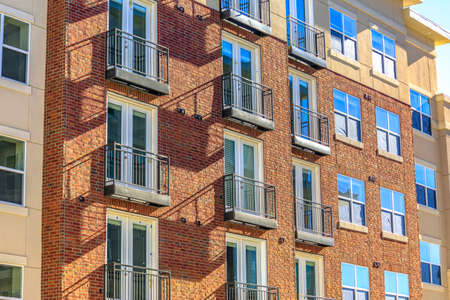1. Understanding Multi-Family Property Types
When it comes to investing in real estate, multi-family properties are a popular choice for both new and experienced investors. These types of properties offer the potential for steady rental income and long-term appreciation. In the U.S., multi-family homes come in various sizes and styles—each with its own set of benefits and considerations. Let’s break down the most common types: duplexes, triplexes, fourplexes, and larger apartment complexes.
What Is a Multi-Family Property?
A multi-family property is a residential building that contains more than one housing unit. Unlike single-family homes, these properties can accommodate multiple tenants under one roof or across several connected units. They’re ideal for people looking to live in one unit while renting out the others, or for investors interested in generating passive income.
Common Types of Multi-Family Properties
| Property Type | Number of Units | Typical Occupants | Main Advantages |
|---|---|---|---|
| Duplex | 2 | Small families or couples | Affordable entry point; live in one unit, rent the other |
| Triplex | 3 | Multiple small households | More rental income than a duplex; still manageable for owner-occupiers |
| Fourplex (Quadplex) | 4 | Diverse tenant mix | Max units under residential financing; good cash flow potential |
| Apartment Complex | 5+ | Larger tenant base | Scalable investment; professional property management often used |
The Appeal of Each Property Type
Duplexes
A duplex consists of two separate units within one building. This setup is perfect for first-time investors who want to ease into property ownership. Many owners choose to live in one unit while renting out the other, helping offset mortgage costs.
Triplexes and Fourplexes
A triplex has three units, while a fourplex includes four. These mid-sized properties strike a balance between affordability and income potential. They’re often financed similarly to single-family homes, which makes them accessible without needing commercial loans.
Larger Apartment Complexes
Apartment complexes typically include five or more units and often require commercial financing. These properties offer economies of scale and are usually managed by professional companies. Theyre best suited for seasoned investors looking to grow their portfolio significantly.
Why Choose Multi-Family Real Estate?
Multi-family investments provide multiple streams of income from one location, making them an attractive option for those wanting consistent returns. Whether you start small with a duplex or aim big with an apartment complex, understanding your options is the first step toward smart investing.
2. Investment Goals and Property Scale
When choosing the right multi-family property type—from duplexes to large apartment complexes—understanding your investment goals and how much youre ready to take on is key. Whether youre a first-time investor or looking to expand your real estate portfolio, your objectives, budget, and involvement level will help guide you toward the best fit.
What Are Your Investment Goals?
Your goals can range from generating consistent monthly cash flow to building long-term equity or even reducing your tax burden through depreciation. Some investors want passive income with minimal hands-on management, while others are ready to roll up their sleeves and actively manage tenants and maintenance. Ask yourself:
- Are you looking for steady monthly income?
- Do you plan to hold the property long-term for appreciation?
- How involved do you want to be in day-to-day operations?
Matching Property Types With Investment Goals
Different multi-family property types offer different levels of control, risk, and return. Here’s a quick comparison to help you understand which might align best with your goals:
| Property Type | Ideal For | Typical Budget Range | Level of Involvement |
|---|---|---|---|
| Duplex/Triplex/Fourplex | New investors, owner-occupants | $250K–$800K (depending on location) | Moderate: Often self-managed |
| Small Apartment Building (5–20 units) | Mid-level investors seeking higher returns | $1M–$5M+ | Medium to High: May need part-time property management |
| Large Apartment Complex (20+ units) | Experienced investors or investment groups | $5M–$50M+ | High: Requires full-time property management team |
Your Budget Matters Too
The amount of capital you’re willing—and able—to invest significantly affects what kind of property you can pursue. Smaller properties like duplexes have lower barriers to entry and may qualify for residential loans, including FHA or VA loans if you plan to live in one unit. Larger complexes typically require commercial financing, more upfront capital, and often a team of investors.
Lending Tip:
If youre planning to buy a property with five or more units, youll likely need a commercial loan—which comes with stricter requirements but also opens doors to larger investments.
Consider How Hands-On You Want To Be
If managing tenants, fixing leaks, and handling late-night emergencies isn’t your thing, opting for a larger building with professional management could be worth the extra cost. On the other hand, smaller properties let you stay closer to the action and potentially save money by managing them yourself.
Quick Guide: Time Commitment by Property Type
| Property Type | Your Role (Typical) |
|---|---|
| Duplex/Fourplex | Often owner-managed; direct involvement in repairs and tenant issues |
| Small Apartment Building | Might hire part-time help; still needs regular oversight |
| Large Apartment Complex | Usually run by full-time professionals; investor focuses on strategy & finance |
The right scale of property depends on where you are financially, how much time youre willing to commit, and what kind of returns youre hoping for. By aligning these factors early on, youll be in a better position to choose a multi-family investment that truly works for you.

3. Financing Options and Requirements
When it comes to investing in multi-family properties—whether its a simple duplex or a large apartment complex—understanding your financing options is key. The size and type of the property will often determine what kind of loan you’ll need and what lenders will expect from you.
Understanding the Difference: Residential vs. Commercial Loans
Multi-family properties with 2 to 4 units (like duplexes, triplexes, and fourplexes) are typically financed using residential loans. Properties with 5 or more units fall into the commercial category, which comes with different requirements and terms.
Loan Comparison by Property Type
| Property Size | Loan Type | Down Payment | Loan Term | Lender Requirements |
|---|---|---|---|---|
| Duplex (2 units) | Conventional Residential Loan / FHA / VA | 3.5% – 25% | 15 – 30 years | Personal credit score, income verification, debt-to-income ratio |
| Triplex & Fourplex (3–4 units) | Conventional Residential Loan / FHA (if owner-occupied) | 3.5% – 25% | 15 – 30 years | Similar to duplex, but rental income can be considered |
| Apartments (5+ units) | Commercial Real Estate Loan | 20% – 30%+ | 5 – 20 years (balloon payments common) | No personal income required; focus on property’s cash flow, business entity needed, detailed financials |
Lender Expectations for Multi-Family Financing
Lenders assess risk differently depending on whether you’re applying for a residential or commercial loan. Here’s what they generally look for:
#1 Personal Credit Score (Residential Loans)
If youre buying a duplex or fourplex using a residential loan, your personal credit history plays a big role. Most lenders require a score of at least 620, though higher scores can help you qualify for better rates.
#2 Property Income Potential (Commercial Loans)
Lenders want to see that the property itself generates enough income to cover the mortgage. They often use something called the Debt Service Coverage Ratio (DSCR), where a ratio of 1.25 or higher is usually required.
#3 Down Payment Requirements
The bigger the property, the larger the down payment tends to be. While FHA loans may allow as little as 3.5% down for owner-occupied triplexes or fourplexes, commercial lenders often expect at least 25% down—sometimes more depending on the market and your experience as an investor.
#4 Experience Matters (Especially for Large Properties)
If youre buying an apartment building with five or more units, lenders may ask about your experience managing similar properties. Some even require you to work with a professional property manager if this is your first large investment.
Tips for First-Time Investors
- Start Small: Consider beginning with a duplex or triplex so you can use residential financing while learning the ropes.
- Add Value: Look for “value-add” opportunities where you can improve units and raise rents over time.
- Create a Business Plan: Especially important when applying for commercial loans—lenders love seeing that you’ve thought through expenses, vacancies, and long-term ROI.
Selecting the right financing strategy depends largely on your goals and experience level. Understanding how lenders evaluate each property type helps you prepare financially and position yourself as a qualified borrower in today’s competitive market.
4. Location and Market Demand
When it comes to choosing the right multi-family property type—from duplexes to large apartment complexes—location and market demand play a huge role in determining your investment’s success. Understanding the surrounding neighborhood and the people who live there helps you match the right type of rental property with the right renters.
Neighborhood Characteristics Matter
The vibe and features of a neighborhood can directly impact what kind of multi-family property makes sense. For example, duplexes might be more appealing in quiet suburban areas where families are looking for more privacy and space. On the other hand, apartment complexes usually thrive in urban centers where theres high demand for housing near jobs, transit, and amenities.
| Neighborhood Type | Best-Suited Property Type | Key Features |
|---|---|---|
| Urban Downtown | Apartment Complexes | High foot traffic, public transportation, younger renters |
| Suburban Areas | Duplexes or Triplexes | Family-oriented, quieter streets, schools nearby |
| College Towns | Fourplexes or Small Apartment Buildings | Student renters, seasonal demand, shared units |
| Growing Cities | Mixed-use or Mid-sized Complexes | Diverse tenant base, potential for appreciation |
Know Your Renter Demographics
The types of people who live in or move to an area can help you decide which multi-family setup is most profitable. Are they young professionals? Families with kids? Retirees? Renters’ needs vary depending on their lifestyle stage, and different property types attract different groups.
Renter Profile Examples:
- Young Professionals: Prefer modern apartments close to work and nightlife.
- Families: Look for duplexes or townhomes with multiple bedrooms and yards.
- Seniors: Often seek low-maintenance living like ground-floor units in smaller complexes.
Local Market Trends Influence Demand
You should also look at what’s currently happening in the local real estate market. Is there a growing tech industry drawing in young renters? Are home prices pushing more families into rentals? Keep an eye on vacancy rates, average rents, and population trends to make smarter choices about which property types will perform best.
Selecting between a duplex and an apartment complex isn’t just about size—it’s about how well that type fits into the community around it. The better aligned your property is with local demand, the more likely youll see strong occupancy rates and solid returns.
5. Management and Maintenance Considerations
When deciding between different types of multi-family properties—like duplexes, fourplexes, or large apartment complexes—its important to think about how much time, money, and effort it will take to manage and maintain the property. The scale of your investment will directly impact these factors.
Time Commitment
Smaller properties like duplexes and triplexes often require less time to manage. You may even be able to handle basic tasks yourself if you live nearby. On the other hand, larger apartment complexes usually involve more tenants, more maintenance issues, and more administrative work. This means a much greater time commitment.
Cost Factors
The cost of managing a property goes up with size. More units mean more repairs, higher utility expenses (if covered by the owner), and possibly full-time staff. However, larger properties can also offer economies of scale—for example, hiring one maintenance team to service many units may be more cost-effective per unit than hiring help for a single duplex.
Complexity of Management
Managing a few units is relatively straightforward—you deal with fewer tenants and simpler systems. Larger properties often involve complex HVAC systems, shared amenities like gyms or laundry rooms, and compliance with stricter safety codes. These complexities may require specialized knowledge or professional help.
Property Management Options
If managing the property yourself isn’t practical or desirable, hiring a property management company is always an option. Heres a quick comparison:
| Property Type | Self-Management Feasibility | Typical Property Management Fee |
|---|---|---|
| Duplex / Triplex | High – Many owners manage themselves | 8%–10% of monthly rent income |
| Fourplex / Small Multi-Unit (4–10 units) | Moderate – Self-management possible but time-consuming | 7%–9% of monthly rent income |
| Apartment Complex (10+ units) | Low – Professional management recommended | 4%–7% of monthly rent income (plus additional fees) |
Additional Considerations When Hiring Help
- Local vs. National Companies: Local companies may offer more personalized service; national firms might have more resources.
- Service Scope: Some managers only handle rent collection; others provide full-service management including maintenance and leasing.
- Licensing and Reviews: Always check credentials and customer feedback before hiring a manager.
Understanding the time, cost, and complexity involved in managing various types of multi-family properties will help you choose the option that best fits your lifestyle and investment goals.


